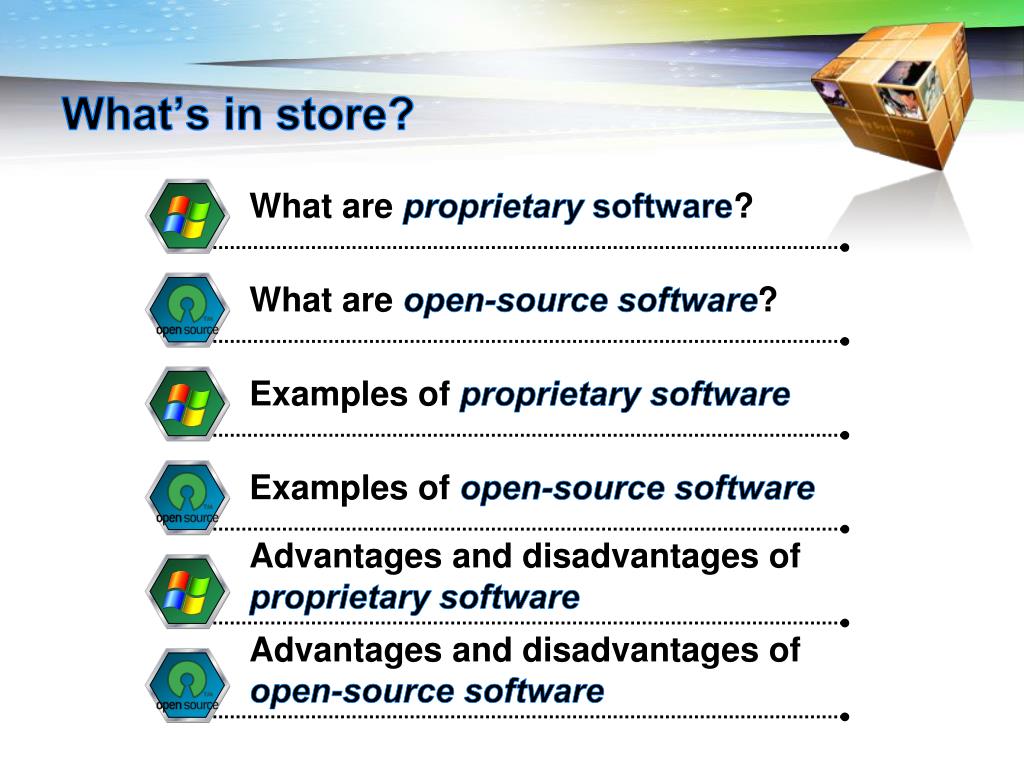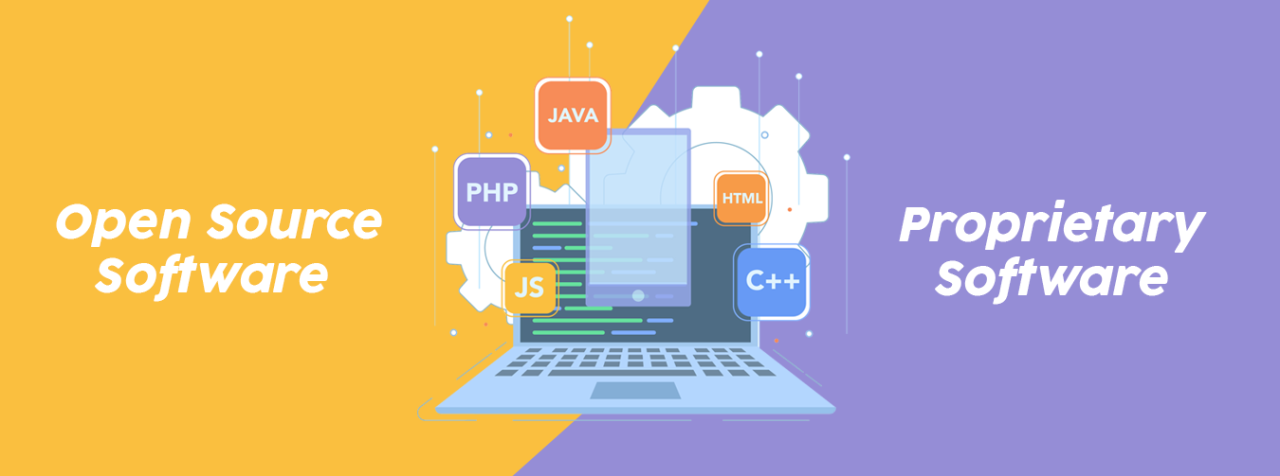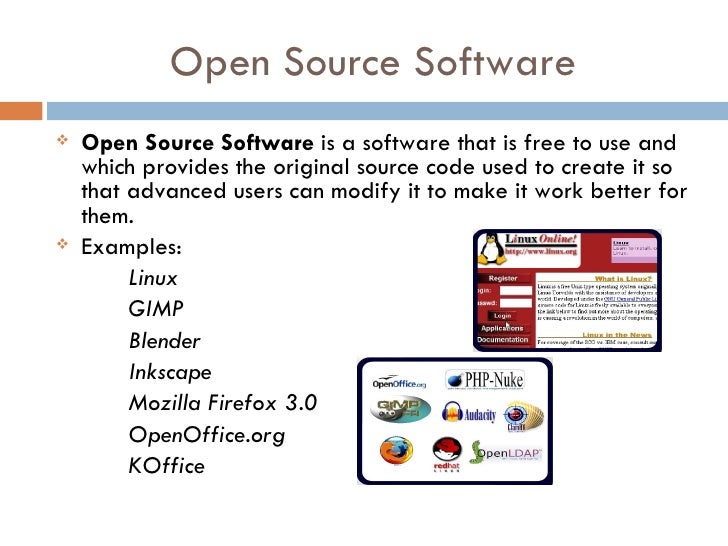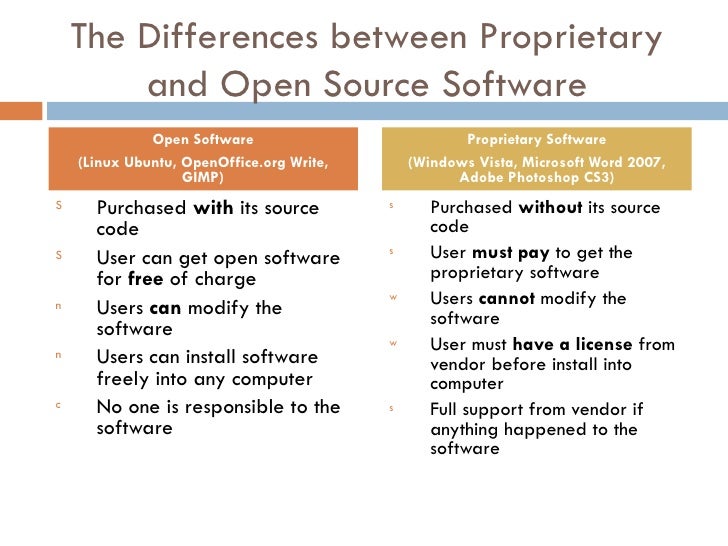Proprietary software, meticulously crafted and carefully guarded, stands as a cornerstone of innovation in numerous industries. This software, often developed in-house or by specialized companies, empowers businesses with tailored solutions, allowing them to achieve unique goals and elevate their operational excellence. From complex financial systems to sophisticated medical tools, proprietary software fuels progress, setting the stage for remarkable advancements.
This exploration delves into the multifaceted world of proprietary software, examining its creation, implementation, and the unique advantages and disadvantages it offers. We will examine the nuances of licensing models, compare its development lifecycle to open-source alternatives, and assess its lasting impact on the future of technology.
Defining Proprietary Software

Proprietary software, unlike open-source alternatives, is controlled by its creator or owner. This control extends to the software’s source code, limiting access and modifications for users. This contrasts sharply with open-source models where the code is publicly available. Understanding the characteristics and legal aspects of proprietary software is crucial for informed decisions regarding software acquisition and use.
Proprietary software is characterized by its closed-source nature, meaning the source code is not publicly available. This fundamental difference from open-source software dictates licensing models, user permissions, and the overall software development ecosystem.
Key Characteristics of Proprietary Software
Proprietary software is often developed by a single entity or company. This company maintains sole control over the source code, licensing, and distribution of the software. This gives them the power to charge fees for use and updates, and to protect their intellectual property. The closed-source nature is a defining feature, ensuring the company’s control over the software’s development and future direction. This model often leads to a strong focus on security and stability due to the company’s internal control.
Types of Proprietary Software Licenses
Proprietary software licenses come in various forms, each with different stipulations regarding use, modification, and distribution. Common types include:
- Single-user license: Allows a single user to install and use the software on a single device. This is common for desktop applications.
- Multi-user license: Permits multiple users to install and use the software on various devices. This type is often employed for enterprise software.
- Site license: Authorizes installation and use of the software on all devices within a specific location, like a company or institution.
- Subscription license: Grants access to the software for a defined period, typically requiring periodic payments. This model is popular for cloud-based services and software-as-a-service (SaaS) applications.
Licensing Models Comparison
Different licensing models for proprietary software vary significantly in their terms and conditions. A single-user license restricts use to a single user, while a site license allows multiple users at a given location. Subscription licenses offer ongoing access but often have periodic fees.
Legal Aspects of Proprietary Software
The legal framework surrounding proprietary software centers on intellectual property rights. Copyright laws protect the software’s expression and code. Software developers often employ patents to protect specific inventions within the software. Agreements with users are legally binding and often include terms of use and limitations on modification. Violating these terms can lead to legal consequences.
Open-Source vs. Proprietary Software
The following table highlights the key differences between open-source and proprietary software models:
| Feature | Open-Source | Proprietary |
|---|---|---|
| Source Code | Available | Not Available |
| Licensing | Usually free | Usually paid |
| Modifications | Allowed | Limited or not allowed |
| Community Involvement | High | Low |
Development and Implementation

Proprietary software, with its unique codebase and functionalities, demands a meticulous development and implementation process. This process must consider not only the technical aspects but also the crucial element of security to protect the intellectual property and ensure the software’s integrity. A robust implementation strategy is vital for seamless integration into existing systems and achieving optimal performance.
Software Development Lifecycle
The software development lifecycle (SDLC) for proprietary software follows a structured approach, ensuring quality and minimizing risks. It encompasses various phases, each contributing to the final product’s success. These phases, from initial planning to deployment and maintenance, require careful consideration of security and scalability. Understanding the specific needs and functionalities is paramount to ensure the software meets the intended goals.
Security in Proprietary Software Development
Security is paramount in the development of proprietary software. The unique nature of proprietary code necessitates robust security measures to prevent unauthorized access, modification, or distribution. Security protocols must be integrated into every stage of the development process, from code design and implementation to testing and deployment. Security measures should be reviewed and updated regularly to address evolving threats and vulnerabilities. This includes incorporating encryption, access controls, and intrusion detection systems to protect sensitive data.
Testing and Debugging
Testing and debugging are critical components of the proprietary software development process. Rigorous testing procedures are essential to identify and rectify potential bugs and vulnerabilities before release. Different testing methods, such as unit testing, integration testing, and user acceptance testing, should be employed to ensure the software functions as expected and meets user requirements. Debugging methodologies, including code analysis and log review, are also crucial to pinpoint and resolve errors. Automated testing tools and techniques significantly enhance the efficiency and effectiveness of the process.
Implementation Process
The implementation of proprietary software involves a systematic approach to integration with existing systems. This process requires careful planning, testing, and coordination to minimize disruptions and ensure smooth transitions. It encompasses various steps, including system analysis, data migration, configuration, and user training. Proper documentation and support materials are crucial for a successful implementation. Careful consideration must be given to potential compatibility issues and system dependencies.
Implementation Strategies
Different implementation strategies exist for proprietary software, each with its own advantages and disadvantages. The phased approach involves implementing the software in stages, allowing for testing and adjustments along the way. The big bang approach, on the other hand, involves deploying the entire software at once, which can be risky but potentially faster. The choice of strategy depends on factors such as project size, budget, and the complexity of the software.
Proprietary Software Development Lifecycle Stages
| Stage | Description |
|---|---|
| Requirements Gathering | This initial phase involves identifying and documenting the specific needs and functionalities required for the software. Gathering comprehensive user input and analyzing the existing processes is crucial for creating a software solution that aligns with user requirements. |
| Design | The design phase focuses on defining the architecture, modules, and interfaces of the software. This includes creating detailed specifications, diagrams, and flowcharts to guide the development process and ensure a well-structured software solution. |
| Implementation | During this phase, developers translate the design specifications into actual code. This stage involves writing, testing, and debugging code to create the functional components of the software. |
Benefits and Drawbacks
Proprietary software, developed and controlled by a single entity, offers unique advantages and disadvantages compared to open-source alternatives. Understanding these factors is crucial for businesses and individuals evaluating software solutions for their specific needs. This section explores the strengths and weaknesses of proprietary software, examining its popularity and cost implications.
Advantages of Proprietary Software
Proprietary software often boasts superior support resources due to the direct relationship between the developer and the user base. Dedicated technical support teams are typically available to address issues and provide assistance with implementation. This personalized approach can be especially valuable for complex applications or when quick resolution is essential. The centralized nature of proprietary software also often leads to more streamlined updates and bug fixes. These updates are typically deployed with the specific needs of the software in mind, optimizing performance and functionality over time.
Disadvantages of Proprietary Software
One significant drawback is the licensing costs associated with proprietary software. These costs can range from one-time purchases to recurring subscriptions, potentially creating a substantial financial burden, especially for organizations with limited budgets. Limited customization options are another concern. Proprietary software is often designed with a specific purpose in mind, offering fewer avenues for modification or adaptation to unique business processes. This inflexibility can be a problem for users with particular requirements. Dependence on a single vendor can also present risks. If the vendor ceases operations or experiences significant issues, the software’s functionality and future updates may be compromised.
Factors Contributing to Popularity
The popularity of proprietary software is driven by several factors. Strong support networks are a key draw for many users. The ability to receive prompt and personalized technical assistance is often a deciding factor, particularly in environments with demanding tasks or stringent timelines. The focus on stability and security in proprietary software development can also be attractive. Developers often invest considerable resources in ensuring the software’s reliability, which reduces the risk of system failures or data breaches. The availability of specific, well-defined features is another factor contributing to the appeal of proprietary software.
Cost Comparison: Proprietary vs. Open-Source
The cost structure of proprietary software contrasts significantly with that of open-source software. Proprietary software typically involves licensing fees, which can vary based on factors such as the number of users, features utilized, or the length of the license agreement. Open-source software, conversely, is typically free to use, with no recurring fees. However, open-source software may require in-house expertise for implementation, maintenance, and support, potentially offsetting the initial cost savings. The costs associated with proprietary software must be weighed against the potential benefits of dedicated support, streamlined updates, and tailored features.
Pros and Cons of Proprietary Software
| Benefit/Drawback | Description |
|---|---|
| Pro: Support | Dedicated support teams provide assistance with implementation and problem resolution, offering a personalized experience. |
| Con: Licensing Costs | One-time or recurring fees can be substantial, potentially impacting budgets, particularly for organizations with limited resources. |
| Pro: Stability and Security | Developers often invest heavily in ensuring software reliability, reducing the risk of system failures or security breaches. |
| Con: Limited Customization | The pre-defined structure of proprietary software may not always adapt to unique business processes, hindering customization efforts. |
| Pro: Specific Features | Proprietary software often focuses on specific functionalities, providing a well-defined set of features optimized for particular tasks. |
| Con: Vendor Dependence | Reliance on a single vendor can present risks. If the vendor faces issues or discontinues operations, the software’s functionality and future updates may be jeopardized. |
Case Studies and Examples

Proprietary software, with its unique code and functionalities, plays a crucial role in many industries. Understanding its various applications and the business models behind its development provides a deeper insight into its impact. This section delves into concrete examples, highlighting successful implementations and the diverse ways proprietary software shapes different sectors.
Popular Proprietary Software Examples
Numerous companies rely on proprietary software for their operations. Examples span across various industries, demonstrating the versatility and importance of this type of software. Microsoft Office Suite, Adobe Creative Cloud, and Autodesk AutoCAD are well-known examples of proprietary software used extensively.
Business Models of Proprietary Software Companies
The business models employed by companies developing and distributing proprietary software vary significantly. Some companies, like Microsoft, utilize a licensing model, where users pay for the right to access and use the software. Others, such as Adobe, offer subscriptions, providing continuous access to updates and features for a recurring fee. These models are often tailored to the specific needs of the target market and the nature of the software itself. Licensing models often involve tiered pricing to cater to different user needs and volumes. Subscription models, in turn, encourage long-term engagement with the software, enabling the developer to generate recurring revenue streams.
Proprietary Software in Different Industries
Proprietary software is deeply integrated into many industries. In finance, proprietary trading platforms and accounting software are crucial for managing complex transactions and maintaining financial records. Healthcare relies on proprietary systems for patient management, medical imaging, and electronic health records. In the manufacturing sector, computer-aided design (CAD) and enterprise resource planning (ERP) systems are indispensable for optimizing production processes.
Detailed Case Study: Successful Proprietary Software Implementation
A successful implementation of proprietary software often involves careful planning and execution. For example, a large manufacturing company transitioning from a legacy system to a new proprietary ERP system needed a phased approach. Initial training sessions for key personnel were crucial. Dedicated support teams were established to address user issues promptly. A comprehensive data migration strategy ensured the transfer of historical data without loss. These steps, along with ongoing maintenance and updates, were essential for a smooth transition and maximizing the benefits of the new system. The company saw significant improvements in efficiency and data management after the implementation.
Summary Table of Proprietary Software Examples
| Industry | Example Software | Description |
|---|---|---|
| Finance | Bloomberg Terminal | Provides real-time financial data, market analysis tools, and news feeds to financial professionals. |
| Healthcare | Epic Systems | A comprehensive electronic health record (EHR) system used by hospitals and clinics to manage patient information and medical records. |
| Manufacturing | Siemens NX | A computer-aided design (CAD) software used for 3D modeling and product design in manufacturing. |
| Education | Microsoft Teams | A collaborative communication and learning platform used for online learning, video conferencing, and file sharing. |
Future Trends

Proprietary software, while established, faces a rapidly evolving technological landscape. Emerging technologies are reshaping industries and presenting both challenges and opportunities for software companies. Understanding these future trends is crucial for strategic planning and staying competitive.
The Impact of Emerging Technologies
Proprietary software will increasingly integrate cutting-edge technologies. Machine learning and artificial intelligence will automate tasks, personalize user experiences, and enhance security. Blockchain technology could improve transparency and security in certain applications, potentially altering the way software licenses and updates are managed. Virtual and augmented reality will create new immersive experiences, requiring proprietary software to adapt and innovate. The adoption of these technologies will require substantial investment in research and development, but the rewards could be significant.
Cloud Computing’s Role
Cloud computing is fundamentally altering how proprietary software is developed, deployed, and accessed. Software as a Service (SaaS) models are becoming more prevalent, allowing users to access and utilize proprietary software through cloud-based platforms. This shift allows for greater scalability, reduced infrastructure costs for developers, and enhanced accessibility for users. However, security concerns and data privacy issues related to cloud storage must be addressed carefully. Data breaches or vulnerabilities in cloud services can directly impact the confidentiality and integrity of proprietary software.
Artificial Intelligence in Software Development
Artificial intelligence is revolutionizing software development. AI-powered tools can automate code generation, testing, and debugging, significantly reducing development time and costs. Machine learning algorithms can identify and fix bugs more quickly, improving software quality and reliability. AI also enables the creation of more intelligent and adaptive software applications, tailoring experiences to individual user needs. However, concerns remain about the potential for bias in AI-generated code and the need for human oversight in the development process.
Challenges and Opportunities
The future of proprietary software presents both challenges and opportunities. Adapting to new technologies, maintaining security in cloud environments, and managing the ethical implications of AI are crucial concerns. However, the potential for innovation and enhanced user experiences is immense. Companies that successfully embrace emerging technologies and address associated challenges will be well-positioned to thrive in the future market. One notable example is the increasing use of AI in cybersecurity software, which helps detect and prevent sophisticated attacks.
Technology Impact Table
| Technology | Impact on Proprietary Software |
|---|---|
| Cloud Computing | Increased accessibility, scalability, and reduced infrastructure costs; however, security and privacy concerns must be addressed. |
| Artificial Intelligence | Automates development tasks, enhances software quality, and personalizes user experiences; ethical considerations and potential biases need careful management. |
| Machine Learning | Improves software performance and user experience by enabling adaptive features and personalized interactions. |
| Blockchain | Potentially enhances transparency and security in software licensing and updates, but requires specific implementation strategies. |
| Virtual/Augmented Reality | Creates new immersive experiences, demanding adaptation and innovation in proprietary software to support these technologies. |
Last Word

In conclusion, proprietary software continues to be a powerful force in shaping the technological landscape. Its careful control over development, implementation, and distribution often leads to enhanced security and bespoke features. While licensing costs and limited modification options are potential drawbacks, the potential benefits of customized solutions and strong support are undeniable. The future of proprietary software hinges on its ability to adapt to emerging technologies and address evolving user needs.





